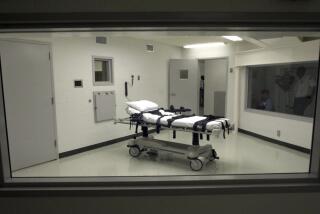Two death row inmates at San Quentin dead in apparent suicides
Two death row inmates have died after they were found unresponsive in their cells, less than 48 hours apart, at San Quentin State Prison.
Authorities believe Andrew Urdiales, 54, and Virendra Govin, 51, killed themselves over the weekend, the California Department of Corrections and Rehabilitation said. There is no indication the two deaths are related, but the back-to-back incidents raise questions about security measures at the prison. Both inmates had their own cells.
Terry Thornton, a spokeswoman for the department, said correctional officers are required to check on inmates in segregated housing at least every 30 minutes, but she did not know the time of Urdiales’ and Govin’s last cell visits. She said inmates under suicide watch have constant supervision, though neither of the inmates had that designation.
The first incident began about 11:15 p.m. Friday, when staff found Urdiales — a former Marine who brutally killed eight women, including five in Southern California — unresponsive during a security check in the prison’s highest security unit, the Adjustment Center, where new arrivals are housed while they are processed.
Correctional officers tried to save him with CPR, but he was pronounced dead a minute after midnight.
About 10:15 p.m. Sunday, staff found Govin unresponsive in his cell in the North Segregation housing unit. He was pronounced dead 15 minutes later.
Since California reinstated capital punishment four decades ago, 25 condemned inmates have committed suicide. In that same period, 79 have died of natural causes, 13 have been executed by the state, and 11 have died of other causes. California has more people on death row — 740 — than any other state. Florida is second, with 346, according to the Florida Department of Corrections.
Urdiales was sentenced to death a month ago by a jury in Orange County for the Southern California slayings he carried out while stationed at various U.S. Marine Corps facilities in the area.
His spree began in 1986, when he attacked Robbin Brandley, 23, as she walked to her car in a dimly lit parking lot after a piano concert at Saddleback College in Mission Viejo. He stabbed her 41 times in the back, neck, chest and hands with a hunting knife.
He was also convicted in the 1988 murders of Maryann Wells, 31, in San Diego, and Julie McGhee, 29, in Cathedral City, as well as the Palm Springs killings of Tammie Erwin, 18, in 1989, and Denise Maney, 32, in 1995. They were all shot in the head.
Urdiales killed three women in four months in Illinois before he was arrested in November 1996 in Indiana after officers saw him in his truck loitering in an area known for prostitution. Officers found a gun in his car that he was not permitted to carry and confiscated it. A year later, Chicago police matched Urdiales’ gun to bullets recovered from the bodies of the three victims.
Urdiales was linked to the Southern California slayings after his arrest. He gave a chilling confession in 1997 that stunned veteran investigators, offering calm and calculated descriptions of the killings.
He had been sentenced to death for the Illinois murders, but after the death penalty was outlawed in the state, he was ordered to serve life in prison without parole. In 2011, Urdiales was extradited to Orange County to stand trial.
Govin, who owned a Studio City motel, had been on death row much longer. He was sentenced to death in 2004 by a Los Angeles County jury in the slayings of a business rival and her three relatives during a bitter dispute over an alley that separated their properties.
The family members were strangled with plastic garbage bag ties, beaten and burned when Govin, his brother and a business partner set the woman’s Hollywood Hills home ablaze. Govin’s brother has been on death row since 2005 in the same case.
Times staff writer Hannah Fry contributed to this report.
Twitter: @AleneTchek
More to Read
Sign up for Essential California
The most important California stories and recommendations in your inbox every morning.
You may occasionally receive promotional content from the Los Angeles Times.











